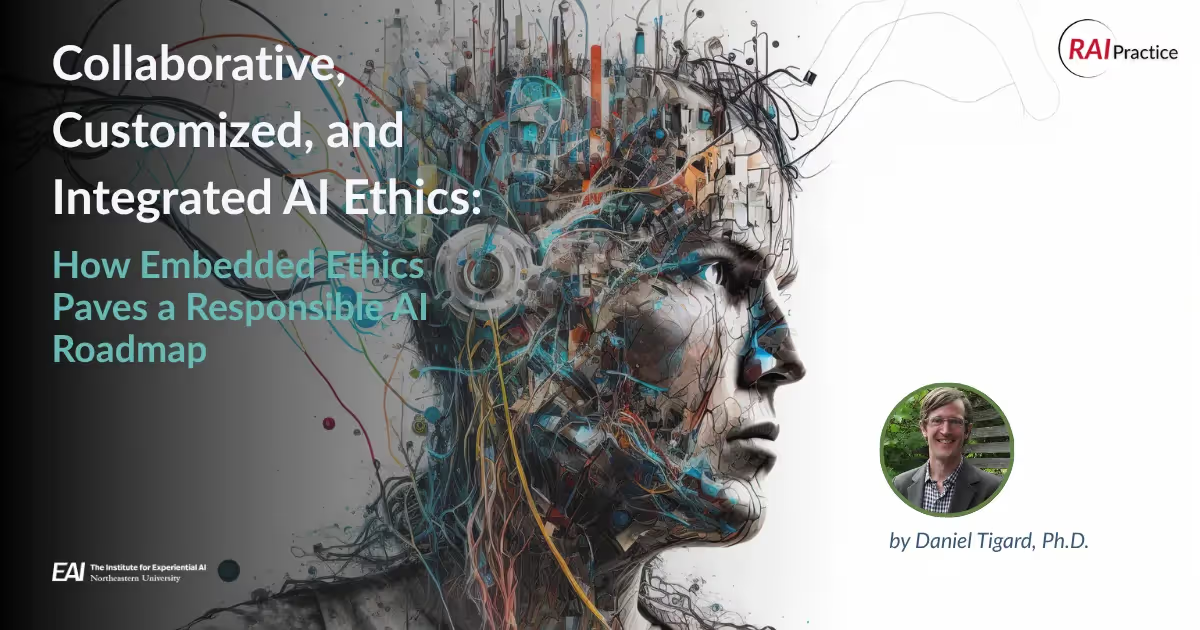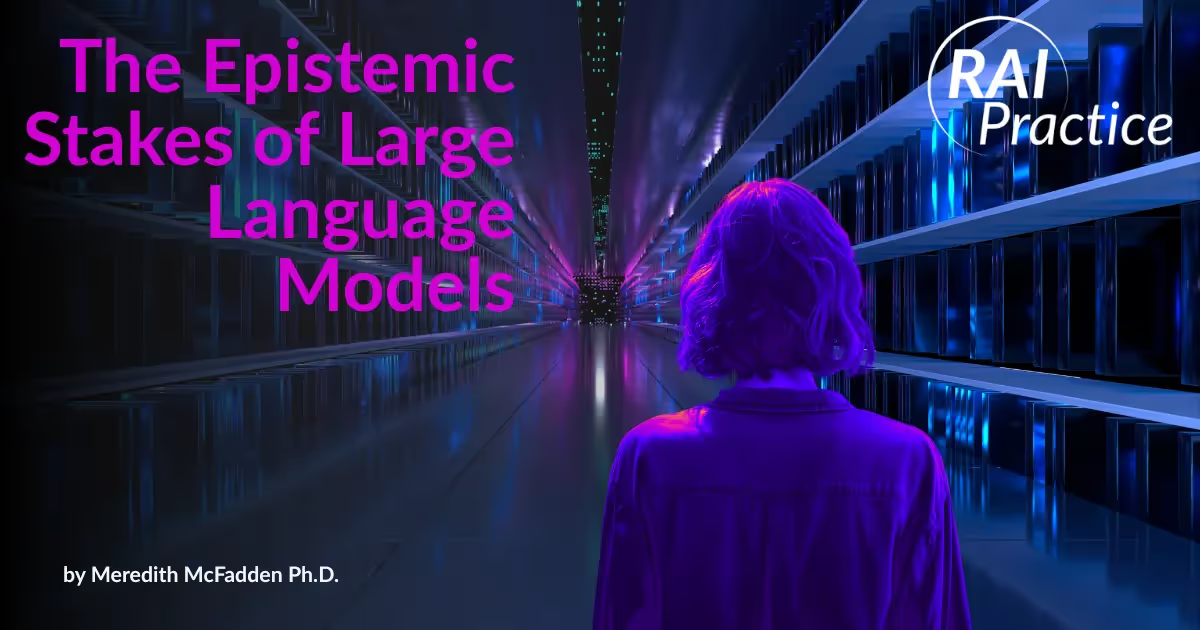Collaborative, Customized, and Integrated AI Ethics: How Embedded Ethics Paves a Responsible AI Roadmap

Traditional approaches to tech ethics run parallel at best. Here’s how “embedded ethics” steers AI development on a fundamentally different – and more effective – path forward.
Anticipation, participation, partnership – these are just a few keywords associated with “embedded ethics,” as voiced by contributors to a recent seminar hosted by Northeastern University’s Responsible AI Practice. When companies consider doing ethics, however, they often settle for external consultants, writing lofty principles, or hiring ethicists to review AI-based products once they’re already built. In short, ethics is too often an afterthought, a checkbox exercise at best running parallel but still separate from actual development and implementation. As one seminar participant put it, “It becomes a way of saying the rest of us don’t need to know about that stuff, because that’s your job.”
Fortunately, a growing movement – known as embedded ethics – takes a drastically different approach. Embedded ethics doesn’t see ethics as a separate domain managed only by siloed specialists. Instead, it truly integrates ethical awareness and reasoning into development teams throughout a product’s lifecycle, fundamentally changing how AI technologies are built and utilized.
What Makes Embedded Ethics Different
Unlike traditional ethics consulting and compliance auditing, embedded ethics isn’t about oversight or regulation. Policies might set guardrails, whether internally or externally, but truly responsible AI development must mean something more. In early embedded ethics projects, I found myself thinking, and increasingly saying, “We’re not here to police you – we just want to help.”
The novelty of the embedded ethics approach is driven by several core features that deliver tangible value to businesses and to society. Here are three aspects brought to the fore by our work at Northeastern.
1. True Collaboration Over Consultation
Although such cooperations are relatively new, already the usual ethics engagements are far too transactional – companies pay for external expertise, receive recommendations, and move on. Embedded ethics, however, builds genuine partnerships. Ethicists and socially conscious tech experts work with developers and users of emerging systems, often for months, not days or even weeks. And when such engagements must be concise – as seen, for example, in executive education modules – they are conducted with an eye to making a long-lasting and widespread impact throughout an organization.
The collaborative approach yields insights that brief consulting engagements are bound to miss. When ethics experts truly understand the goals, values, and limitations an organization faces, and when every level of the organization’s representatives truly understand the social implications of their choices, both sides can make better decisions. As one participant emphasized, “We want the ethical considerations…to really be like a core part of the development process itself.”
No doubt, the case for benefiting businesses and society is clear: better collaboration leads to products that better align with users’ values, and thereby products that are more likely to be adopted widely with desirable impacts. When development teams understand the range of user values and concerns – and not just the technical usability – they’re better positioned to build systems people can rely on and stand by.
2. Customized to Context
Every organization, every product, and every use case is unique. Cookie-cutter ethics checklists are simply less effective, as they aren’t attuned to the specific use contexts and variety of stakeholder interests.
Building upon its collaborative foundations, embedded ethics can adapt to the unique challenges and goals held by each individual organization. Working with algorithmic decision-making for finance or social media presents importantly different sets of considerations than building robotic systems for healthcare or transportation. With the ability to customize our analysis and resources to each context, embedded ethics ensures that the ethics work isn’t abstract – instead, ethics becomes concrete and actionable.
From a business perspective, the customizability of embedded ethics means guidance that doesn’t so much constrain, but indeed fits within existing workflows and bolsters efforts to push the work forward. In the recent words of a seminar participant, “We want to hear their goals and try to really address their concrete situation.” Instead of generic principles or prefabricated guidelines that offer little practical assistance, embedded ethics offers tailored frameworks and tools that help make productive and ethically-sound decisions.
3. Truly Integrated Ethics
Perhaps most importantly, embedded ethics doesn’t just add ethics to existing development or AI use – it allows ethical sensitivity and responsiveness to be woven into the work across an organization. Such deep integration cannot be as effectively accomplished merely with occasional ethics modules or external reviews. As my recent research stresses, what we aim to foster is “a keen sensitivity in developers themselves, an ability to recognize and effectively think through the social and ethical dimensions of technological systems.”[2]
The truly integrated approach delivers a tangible benefit to businesses and society – it helps those who develop and use AI to better anticipate the goals and concerns of individuals who may be impacted. Building upon the benefits of collaboration, truly integrating the ethics work can help to create products and services that better align with distinct human values.
When AI developers and users understand these dynamics, they can be proactive and work to design desirable features of products which are thereby more likely to be adopted. In other words, we don’t need to ‘move fast and break things’ – but we also don’t need to drastically slow down development in every domain. With ethics customized and truly integrated, we can find ourselves in a position to move fast and build positive things for society.

Paving a Responsible AI Roadmap
Sincere attention to ethics steers organizations toward building and implementing AI-based systems in ways that reflect and promote real-world interests and values. In this way, embedded ethics offers a socially responsible route but also proves to be a competitive business advantage. Teams within public organizations and private companies alike can anticipate and seamlessly incorporate ethical factors so as to avoid the pitfalls of redesigns or user backlash.
The path forward is not paved simply with technological innovation. Indeed, the most innovative organizations treating ethics merely as an afterthought will lag behind in a world where people increasingly demand that emerging technologies accurately reflect their values. The destination of an AI-driven world may well remain an open question. But the road for organizations building and utilizing AI systems should be noticeably smoother for those undertaking a collaborative, customized, and truly integrated approach to ethics.
References
[1] With assistance from Claude Sonnet 4, namely in collating the 53-page transcript of our June 20th workshop: “Who Are Embedded Ethicists? A Workshop on the Roles, Training, and Practices at the Heart of Responsible AI”
[2] Tigard, D.W., Braun, M., Breuer, S., Fiske, A., McLennan, S., & Buyx, A. (2024). Embedded Ethics and the “Soft Impacts” of Technology. Bulletin of Science, Technology & Society, 44(3-4), 73-83.


.avif)

.avif)
